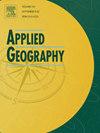邻里食品店的死亡:通过可解释的机器学习解开食品零售环境脆弱性的空间决定因素
IF 5.4
2区 地球科学
Q1 GEOGRAPHY
引用次数: 0
摘要
零售环境的全球转型导致小食品店普遍关闭,威胁到城市的可持续性和饮食健康。虽然广泛的研究已经探讨了城市环境和食品店关闭之间的关系,但大多数研究都没有区分健康和不健康食品店的关闭。为了解决这一差距,本研究采用可解释的机器学习方法,研究了2019年至2024年中国杭州市中心4328个社区健康和不健康食品门店关闭的空间因素的异质性和差异。结果表明:(1)健康食品门店关闭率中位数(47.2%)显著高于不健康食品门店关闭率中位数(27.4%),尤其是在城郊区;(2)空间变量对食品店关闭的影响因街区位置而异;(3)超市密度高(1.5家/km2)降低了健康门店的关闭风险,小型零售门店密度高(200家/km2)降低了不健康门店的关闭风险;(4)改善连通性指标,提高公交站位和人行道密度,更好地保护健康门店。基于这些发现,我们提供了政策见解,以促进更公平、更健康和更可持续的城市食品零售环境。本文章由计算机程序翻译,如有差异,请以英文原文为准。
The death of neighborhood food outlets: Untangling spatial determinants of food retail environment vulnerability via interpretable machine learning
The global transformation of the retail environment has led to the widespread closure of small food outlets, threatening urban sustainability and dietary health. While extensive studies have explored the relationship between urban environments and food outlet closures, most of them do not differentiate between the closures of healthy and unhealthy food outlets. To address this gap, this study employs interpretable machine learning methods to examine the heterogeneity and differences in the spatial factors influencing healthy and unhealthy food outlet closures across 4328 neighborhoods in central Hangzhou, China, from 2019 to 2024. The findings reveal the following: (1) the median closure rate of healthy food outlets (47.2 %) was substantially higher than that of unhealthy ones (27.4 %), especially in suburban areas; (2) the impact of spatial variables on food outlet closures varied by neighborhood location; (3) a high supermarket density (>1.5 stores/km2) reduced the closure risk of healthy outlets, while a high density of small retail outlets (>200 stores/km2) mitigated closures of unhealthy outlets; (4) improved connectivity indicators, such as higher bus stop and sidewalk density, better protected healthy than unhealthy outlets. Based on these findings, we provide policy insights to foster a fairer, healthier, and more sustainable urban food retail environment.
求助全文
通过发布文献求助,成功后即可免费获取论文全文。
去求助
来源期刊

Applied Geography
GEOGRAPHY-
CiteScore
8.00
自引率
2.00%
发文量
134
期刊介绍:
Applied Geography is a journal devoted to the publication of research which utilizes geographic approaches (human, physical, nature-society and GIScience) to resolve human problems that have a spatial dimension. These problems may be related to the assessment, management and allocation of the world physical and/or human resources. The underlying rationale of the journal is that only through a clear understanding of the relevant societal, physical, and coupled natural-humans systems can we resolve such problems. Papers are invited on any theme involving the application of geographical theory and methodology in the resolution of human problems.
 求助内容:
求助内容: 应助结果提醒方式:
应助结果提醒方式:


